In her first year of life, our older daughter Gemma camped in the snow, hiked the Cascades, explored the Colorado Plateau, and visited a variety of terrain from sea level to 12,000 feet above. Through it all, she remained a happy, healthy baby and simply adores being outside, rain or shine.
Now that she’s 7 years old, Gemma’s enthusiasm for the outdoors has only intensified, and her little sister Ember is being primed for adventure as well.
Read more: Parent-Tested Tips for Camping With a Baby (and Actually Enjoying It!)
What’s your secret to taking a baby outdoors? other parents want to know.
And while they think my answer will be one of the many pieces of gear we’ve acquired since becoming parents ourselves (we definitely don’t travel lightly), I always tell them it comes down to one thing: layers.
For as long as I’ve been recreating outdoors, I’ve always sung the praises of layering properly with a few quality pieces that pay for themselves over and over again. Staying warm and comfortable is key to enjoying the outdoors, and that holds true for babies and toddlers as well.
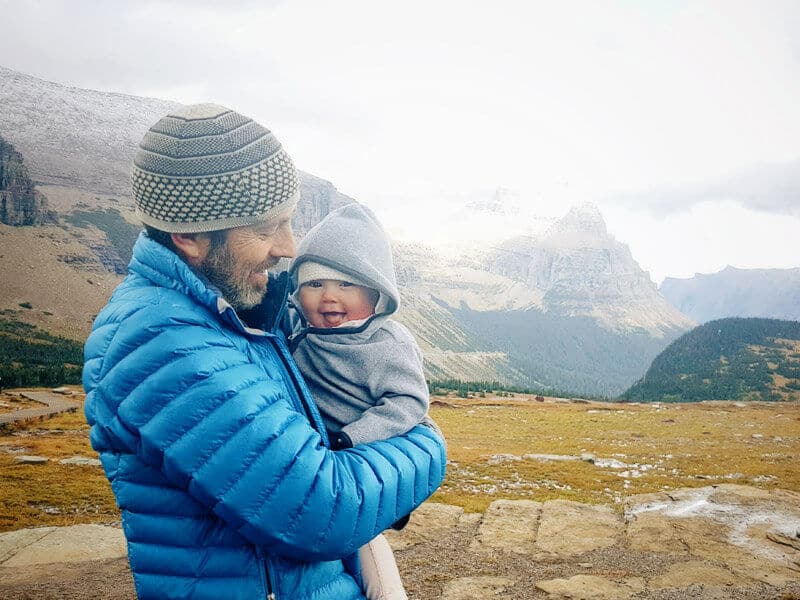
Related: Teach a Kid to Snowboard (How We Did It With a 10-Month-Old Baby)
Over the last few years of traveling with little ones, I’ve tried many brands and materials from mass market to high end. I’ve finally perfected my system for dressing babies and toddlers for cold winter weather, and compiled all that I’ve learned in this updated gear guide.
Layering up: The Baby Sandwich
In my view, there’s no such thing as bad weather, just bad clothing.
By dressing your little one in layers, especially well-chosen layers that wick moisture, dry quickly, and retain heat, you’ll be prepared for any type of weather you might encounter year-round, especially if you head up to higher elevations to play.
I call it the Baby Sandwich.
The Baby Sandwich = baselayer + mid/insulating layer + outer layer.
This is my no-fail formula for a fun day outside!
Baselayer: Wool (or polypropylene) top and bottom, wool socks, and if extremely cold, a balaclava
Mid/insulating layer: Fleece top and bottom (or down/synthetic down jacket) and hat
Outer layer: Waterproof shell, mittens, and booties/boots
A few of the items may change a little as your child gets older (for example, separate shirts and pants instead of onesies and footies, or fingered gloves instead of thumbless mitts), but for the most part, the Baby Sandwich works for all ages (even adults).
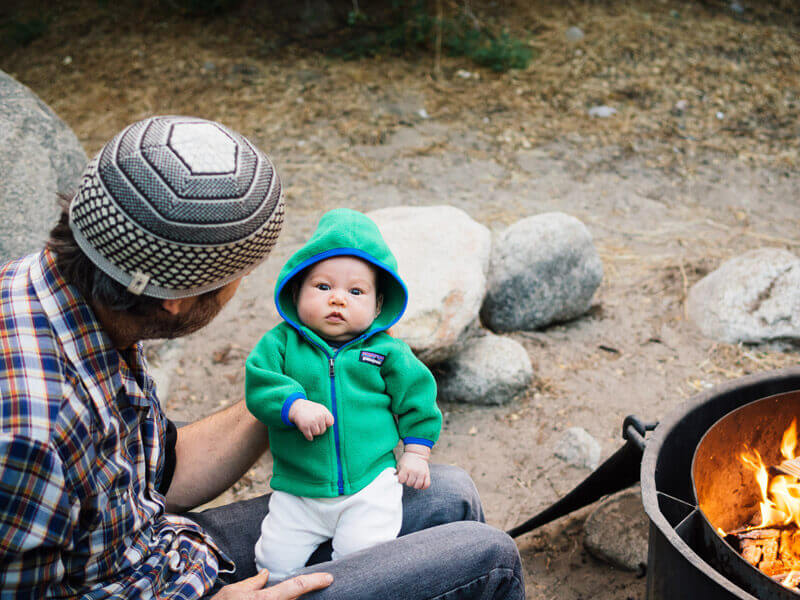
Disclosure: If you shop from my article or make a purchase through one of my links, I may receive commissions on some of the products I recommend.
The best baby winter clothes and cold-weather layers for toddlers
Baselayer
It’s easy to go down the gear rabbit hole when shopping for kids, and it’s especially daunting when they outgrow clothes so quickly at this stage. If hand-me-downs or secondhand items aren’t available, the one thing I’d say to spend money on is the baselayer.
The baselayer is the most important layer on your baby since it sits against the skin. It should fit snugly, wick away moisture, be highly breathable, and feel warm even if it gets wet.
If you can’t remember all that, just remember this: baselayers should never be cotton.
Cotton is a buzzkill because it holds sweat against the skin. Sweat cools quickly and in wintry conditions, the constant cold moisture can lead to hypothermia. For that reason alone, don’t skimp in this area.
Merino Kids Long-Sleeve Pajama Set: I love merino wool because it’s soft and thin, hypoallergenic, and naturally odor-resistant. It stays warm in winter yet cool in summer, and excels at regulating body temperature. It’s a layer that your baby can wear year-round, which makes its cost more justifiable.
Our toddlers had a set that they’ll sometimes wear three or four times before I wash it, since it doesn’t soil as quickly as their other clothes. (On laundry day, I toss it in the washer on a gentle cycle with this delicate wool wash that contains lanolin.)
This brand and style seems to run a little large, so we get an extra year of use by rolling up the sleeves and legs. (They also make a one-piece merino wool set that works well for babies.)
Merino wool in very small (newborn to infant) sizes is surprisingly hard to find in the US, but European brands like Janus and Engel offer a decent selection of bodysuits, tops, and pants online. Just be sure to follow the laundry care label, as many of their garments can’t be machine washed.
Woolino Long-Sleeve Pajama Set: They’re labeled as pajamas, but these tops and bottoms work perfectly as baselayers for a day of adventure. They’re thin, soft, and cozy—don’t be fooled by how lightweight they are.
Patagonia Capilene Midweight Set: I swap between this polypro set and the merino wool set as our only baselayers, and they perform equally well. What I especially love about Patagonia’s set are the reinforced knees, since babies can crawl around in them all day without wearing them out so easily.
The infant Capilene comes in the smallest of sizes to fit a baby from birth, but it does run large—a feature I didn’t mind, as it meant my kids could wear it an extra season.
Smartwool Toddler Socks: I’m a longtime fan of Smartwool, and was so happy to learn they made socks for even the littlest feet.
These are the warmest socks I’ve found for a baby, and they have the softest, plushest cushioning on the ball and heel. On extremely cold days, you can double up on the socks before you put on booties to keep those toes extra snug.
Be forewarned that the sizing is strange. Gemma had average-sized feet for a 10-month-old, at 4 inches long, and the 3T socks fit her perfectly until she was 16 months. (As a bonus, these socks work nicely as mittens for babies.)
Woolino Socks: I love these wool socks for little ones; they’re soft and warm and never scratchy. You can unroll the cuffs and pull the socks all the way up your baby’s legs so they fit snugly and keep her extra toasty. For lazy days around the house, they’re perfect with a onesie.
Wool-Blend Socks: Once our kids outgrew their infant Smartwool socks, we started buying these wool-blend socks from ages 2 and up. I love their thickness, all the fun colors and patterns, and how inexpensive these socks are. They tend to shrink over time (even if you air-dry them) but for the price, you can’t go wrong.
tevirP Merino Wool Balaclava and Turtle Fur Shellaclava: A lot of balaclavas cover the whole face for maximum cold and wind protection, but for babies, I like these styles as they keep the head and neck warm without obstructing airways. (How about that adorable snowflake print on the merino wool knit!)
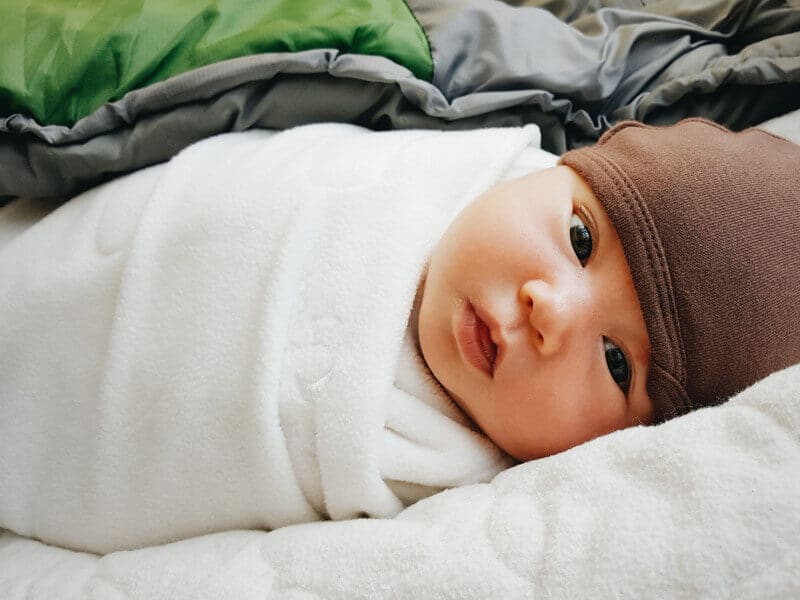
Mid/insulating layer
In the grand scheme of things, this is the least important layer to “get right,” so save some money here by using what you have (even a simple wool sweater works) or scouring consignment shops and thrift stores.
The objective is just to find something that keeps your baby warm. If you have a toddler who’s actively running around, you can keep this layer stashed in a pack and only put it on when he stops moving (otherwise you’ll end up with a damp sweaty kid).
For short outings on milder days when no wind, rain, or snow is expected, dressing your baby in just a base layer and mid layer should be sufficient (but you should always try to pack an outer layer if you can).
Halo SleepSack Micro-Fleece Swaddle: In those early months, a fleece swaddle was a lifesaver (especially one that transitioned easily from arms-in to arms-out). We used ours on every camping trip until four months old, and would have continued using it had the weather not turned so warm. Hands down, it was one of the most useful items we purchased.
Columbia Baby Snowtop II Bunting: For infants and toddlers, one-piece suits are where it’s at. It’s so quick and easy to zip your kid up in a single piece of clothing when you’re trying to get out of the car and wrangle all your gear.
I’ve bought this bunting in every size from 3-6M to 18-24M. It’s extra roomy to allow for layers underneath, and is so luxuriously soft that I wish it came in my size too!
Patagonia Baby Synchilla Fleece Cardigan: Our first Synchilla cardigan was a baby shower gift, and we loved it so much that we bought another one (secondhand) a couple sizes up, and hope to continue buying more as our kids get older.
What can I say, we’re a Patagonia-loving family because the brand never fails us. (For a more budget-friendly option, check out the Columbia Baby Benton Springs Fleece Jacket, which we also have and like a lot.)
Zutano Cozie Fleece Cuff Pants: These pants are soft, cozy, and can be worn with or without a baselayer underneath. Since I preferred to put our toddlers in a zip-up one-piece if they have to wear a mid layer at all, I usually save these for slightly warmer days when they need thicker pants but not a full suit.
The North Face ThermoBall Insulated Jacket: This synthetic down jacket is super warm, incredibly lightweight, and highly compressible, making it very easy to stuff into your pack. I love the fold-over mitts on the sleeves, which we always use (sometimes with mittens underneath for extra warmth).
It comes in a range of sizes to fit from birth, and is one piece you should consider buying at every age once your child starts spending significant time outside.
Hat: Any thick, warm hat will work and as usual, avoid cotton. The North Face Baby Faroe Beanie and Patagonia Baby Reversible Beanie are two of our favorites since they’re lined with fleece and cover the ears so well.
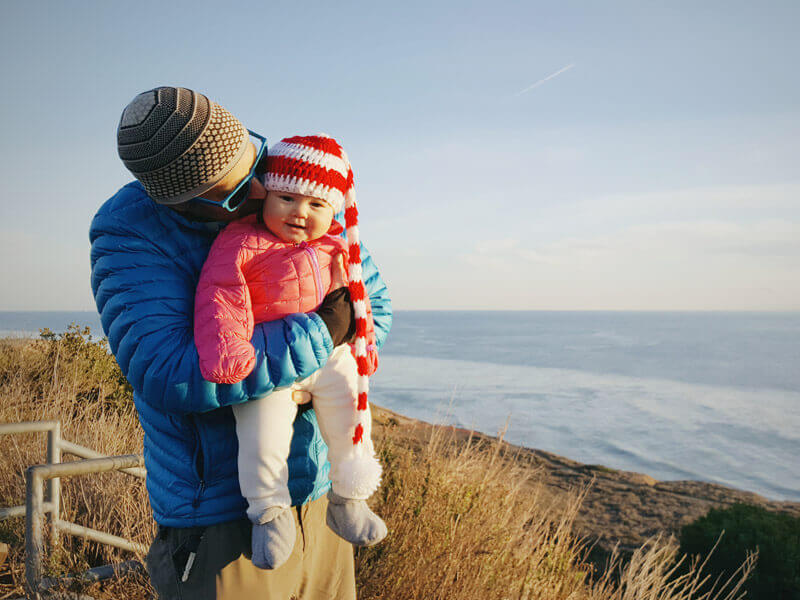
Outer layer
This crucial layer in the baby sandwich protects your little one from the elements. It fends off whatever wild weather that winter throws at you—be it rain, snow, or hail—and keeps it away from the body and the mid layer so your baby stays dry and warm. Look for quality materials that offer water repellency and wind blocking.
Skip Hop Stroll–and-Go Three-Season Footmuff: This footmuff attaches to our City Mini GT stroller (as well as other strollers) and keeps the baby warm without the need to bundle her up in bulky layers. (That means no more struggling with a harness belt over a coat!)
I can just dress her in a baselayer (and maybe a fleece suit if it’s especially cold out) and tuck her into the footmuff for an outing.
The great thing about this style is the bottom zipper that lets dirty shoes hang out. This feature also extends its useful life for taller kids, so you can get a few winters out of the toddler version.
ErgoBaby Rain Cover and Columbia Baby Rain Suit: For rainy day hikes, a water-resistant layer with a hood is a must. The ErgoBaby works great for younger babies and fits our Lillebaby carrier, so it should work with similar soft-structured carriers as well.
Older babies in backpack carriers (like this one that we use and love) can stay dry in the Columbia rain suit, which isn’t the most breathable but is perfectly fine for babies that aren’t yet mobile. For extra warmth on chilly days, I layer either of these over a one-piece fleece suit.
Jan & Jul Waterproof One-Piece Rain Suit: If there’s a muddy puddle somewhere, my kids will find it! And I’m a fan of this one-piece suit because it keeps water out—everywhere—and is so easy to slip on and off a squirmy toddler. I like to buy this one size larger to make room for layers underneath and get more seasons out of it.
Jan & Jul Waterproof Rain Pants: You can still have fun at playgrounds when it’s raining out. All you need are these waterproof pants to keep your little ones dry on the swing set, slide, and teeter-totter. I love how these are lined with fleece for extra warmth and aren’t just a crinkly thin shell.
Columbia Baby Frosty Freeze Bunting: I like to call this the marshmallow suit! (Or the Michelin Man suit.) For snowplay, a one-piece snowsuit is indispensable. The fold-over cuffs on the hands and feet are brilliant and help keep all the cold and moisture out. It’s well insulated, so you only need a baselayer underneath.
This is what we dressed both our toddlers in for a day out snowboarding since it’s one less article of clothing to adjust (or accidentally leave behind in the lodge).
Arctix Snow Bibs: I bought these bibs one year on a whim since I needed an extra pair to leave at my daughter’s preschool. They were a great deal, but I had no idea how much I’d love them for the snow.
They’re insulated, waterproof, rip-resistant, easily adjustable, and come in tons of fun colors—all for under $35. (Sometimes you can even find certain colors for under $20.) I’ve since bought a new pair every winter and our kids spend a lot of time in the snow in weather down to the low 20s°F. It’s a no-brainer here—get them!
Patagonia Baby Puff Mittens: I’ve ordered several kinds of mittens from different brands, and ultimately kept these ones because they’re water-resistant, windproof, and well insulated.
I got them one size larger because for a baby, we didn’t bother with the thumb and just slipped our babies’ hands into the main mitten part. They fit fine that way, especially since we use the foldover cuffs on her one-piece suits and jackets for extra warmth.
(The extremities is where warmth is easily overlooked, since you may not realize that a baby in a carrier is not working up a sweat the way you are.)
If all you want are simple fleece mittens, my favorite of the few I’ve tested are the Patagonia Baby Pita Pocket Mittens because of the longer cuffs.
Stonz Mittz: For more active babies who love to play in the snow, these thumbless waterproof mitts are the way to go. They slide over the sleeves, not under, to keep snow from sneaking inside your child’s layers. (It also makes it much easier to get the mitts on and off your child.)
Gordini Easy On Mitts: For toddlers who need a bit more dexterity in the snow, I really like these wide gauntlet mitts.
You know how hard it is to slip your child’s tiny hand into a mitt while making sure the thumb is properly placed? These mitts have a super long zipper on the side to help with that. They’re also super warm and waterproof with grippy palms, and are very easy to put on over a jacket sleeve.
Zutano Cozie Fleece Booties: Our babies wore these all through winter, and they’re fantastic for inside the house too. They’re soft, warm, and most importantly, stay on those happily kicking and busily exploring feet. On very cold days, I add a pair (sometimes two pairs) of socks.
Recently, I tried these Luvable Friends booties and they seem almost exactly like the more expensive Zutano, only with a hook-and-loop closure around the ankle. Love them just as much, and the price point makes it possible to buy a few pairs without breaking the bank.
Stonz Three-Season Baby Booties: If you have an early walker, these soft-soled booties allow your baby to wander through the snow without getting his socks or feet wet. They make a special fleece liner that you can layer underneath, but a pair of warm fleece booties works just as well.
Sorel Toddler Snow Commander Boots: For more active adventurers (and steady walkers), a sturdy pair of waterproof insulated boots with grippy bottoms is essential for keeping them safe, dry, and warm.
When it comes to outfitting kids, I tend to gravitate toward brands I use and trust for my own outdoorwear, and Sorel is one of them.
Bogs B-Moc Snow Boots: This is another great option for toddlers. You might already know Bogs for their rubber gardening boots (at least, that’s how I was introduced to them years ago), but I really dig (hehe) their baby line.
The pull-on handles are key for dressing a squirmy kiddo! And they offer tons of adorable prints and fun colors. They’re lighter and less bulky than the Sorels, so might be a better option for brand-new walkers.
Tundra Snow Boots: This is a company out of Canada, so you know they know their winter gear! Our younger daughter Ember had just started walking when winter came around, and hard-soled snow boots were too difficult for her to walk in.
This pair still has a sturdy sole for trekking outside, but is lower to the ground (not a platform the way Sorels are) and opens wide to get those chubby baby feet in all the way. Plus, the Tundra boots are waterproof and extremely warm (we’ve used them down to 30°F so far).
Baby Banz Retro Banz Oval Baby Sunglasses: This isn’t a layer per se, but I wanted to include this because protecting your baby’s eyes is just as important as keeping her warm.
If your child doesn’t already have goggles for snowsports, a well fitting pair of sunglasses is a must. These have a comfortable wraparound Velcro strap that helps them stay on, and I like how adjustable they are so we can get a couple years of year-round use out of them.
(Baby Banz offers other styles if you aren’t cheesy like me and want your child to wear matching “Mommy and me” sunglasses.)
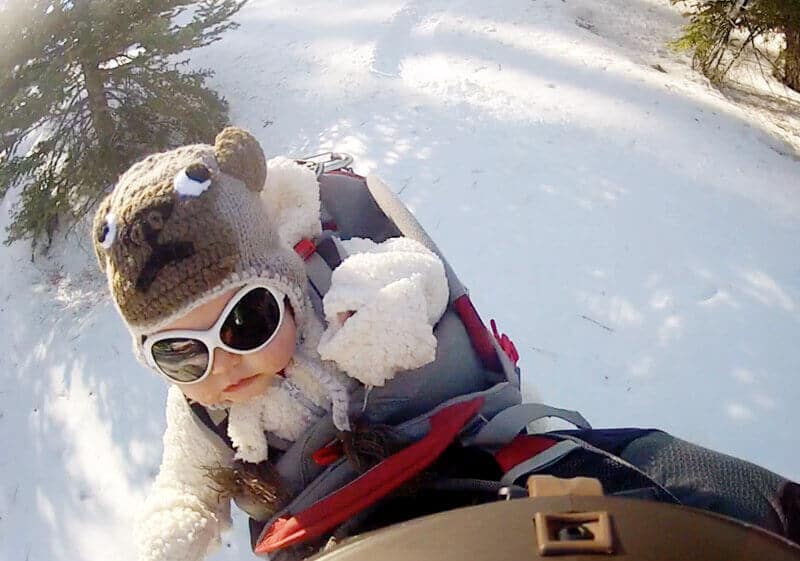
How to dress your kids for winter if you’re on a budget
I used to wonder why kids’ adventurewear nearly cost the same as their adult versions when they used a quarter of the materials. (I know I know—labor is still the same, even for a tiny garment.)
If you’re an adventurous family, all that clothing adds up. Here are my tips for scoring good deals and saving money without sacrificing warmth, comfort, and important technical features.
Pass it down. If you have or plan to have more babies, it makes sense to buy new (and in neutral colors) so you can pass it down to the next child.
For certain items that can be generously sized without affecting performance, such as snowsuits, you can likely get two years out of them, giving the family four (or more) years of use from one investment.
Resell outgrown clothing. If you’re buying new, this is a good reason to buy new and name brand: resale value.
There’s certainly nothing wrong with buying from Target, but quality brands like Patagonia and The North Face are priced on the higher end because they’re known to last. You can fetch a fairly good price for these items on eBay, Craigslist, or your local Facebook Marketplace and “mom swap” groups.
Shop consignment or thrift stores. I’ve learned that thrift stores in mountain towns are especially good for finding gently used winter wear for kids. Since babies outgrow clothing so quickly, oftentimes they only get a couple of wears before they’re too small.
While passing through Leadville, Colorado, on a road trip one year, I found a Patagonia Synchilla jacket, size 2T and still in great condition, for only $8! Some thrift stores even specialize in outdoor goods, so be on the lookout for those.
Shop off-price department stores. Deeply discounted chain stores like Ross, Marshalls, and T.J. Maxx can be hit or miss when it comes to name-brand winter wear, but when they hit, they are a big hit.
Example: I stopped in to Ross in Bend, Oregon, one day and found The North Face ThermoBall jacket, size 12M, for $30! (The same style and color retailed for $80 online.)
I don’t have quite as much luck shopping these stores in urban areas, so like my advice above, I think mountain towns or communities focused on outdoor recreation will be your best bet.
Shop outlet stores. Of all the discount stores mentioned here, outlets are my last resort. It’s a common misconception that outlets sell seconds, overstock, and past-season goods, and they do—but to a very small extent.
Oftentimes, their main merchandise is specifically manufactured for the outlets (using inferior materials) so you’re not really getting that good of a deal.
Nonetheless, I’ve scored some decent jackets for toddlers at my local Columbia Sportswear Outlet, so they’re usually worth a stop if you have the time.
Buy off-season. This is my personal favorite tip for buying baby clothes on the cheap. Winter wear goes on sale after February, and by June, I’ve stocked up on last season’s fleeces and woolens when everyone else is shopping swimsuits and sun hats.
I’ve been able to score high-quality staples from the likes of Burton, Patagonia, and Columbia for 30 to 60 percent off this way. I like to scour the babies’ selection at Backcountry and often find great deals directly from Smartwool.
Size up for snowsuits. Since snowsuits have a shorter season than other items in your baby’s cold-weather wardrobe, it’s best to buy them as large as possible without hindering movement or compromising safety. They tend to be generous in cut to allow for layers, so it’s possible to get two winters out of them.
Gemma was 9 to 12 months old during her first winter and wore a 12-18M snowsuit. The arms were a little long but helped keep her hands warmer, and she still fit the suit the following winter.
Baby and Toddler Winter Clothing Sources
[show_shopthepost_widget id=”4321140″]
Merino Kids Pajama Set | Merino Kids All-In-One | Woolino Pajama Set | Patagonia Capilene Midweight Set | Smartwool Socks | Woolino Socks | Anlisim Wool-Blend Socks | tevirP Merino Wool Balaclava | Turtle Fur Shellaclava | Halo SleepSack Micro-Fleece Bunting | Columbia Snowtop II Bunting | Patagonia Synchilla Cardigan | Columbia Benton Springs Fleece Jacket | Zutano Cozie Fleece Cuff Pants | The North Face Thermoball Insulated Jacket | The North Face Faroe Beanie | Patagonia Baby Reversible Beanie
[show_shopthepost_widget id=”4321141″]
Skip Hop Stroll-and-Go Three-Season Footmuff | ErgoBaby Rain Cover | Columbia Baby Rain Suit | Jan & Jul Waterproof One-Piece Rain Suit | Jan & Jul Waterproof Rain Pants | Columbia Frosty Freeze Bunting | Arctix Snow Bibs | Patagonia Puff Mitts | Patagonia Pita Pocket Mittens | Stonz Mittz | Gordini Easy On Mitts | Zutano Cozie Fleece Booties | Luvable Friends Cozy Fleece Booties | Stonz Three-Season Baby Booties | Sorel Snow Commander Boots | Bogs B-Moc Snow Boots | Tundra Snow Boots | Baby Banz Retro Banz Oval Baby Sunglasses
This post updated from an article that originally appeared on February 27, 2017.
View the Web Story on how to dress babies and toddlers for cold winter weather.


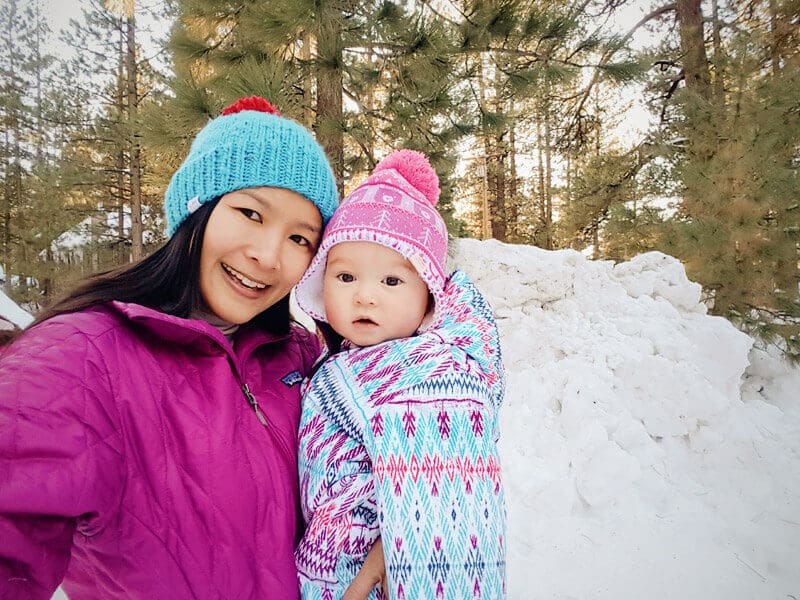













This is so helpful! The specific product recs are seriously going to save me soo much time! Thank you!
THANK YOU for this post! I’m taking my toddler to see snow and had no idea what to dress her (or myself) in. Born and raised in Florida so we had no idea! Now I feel confident I can keep her warm!
Best Winter Gear for Kids (the coats we swear by cherrycrumble and the sweatshirts for the kids’ are amazing)